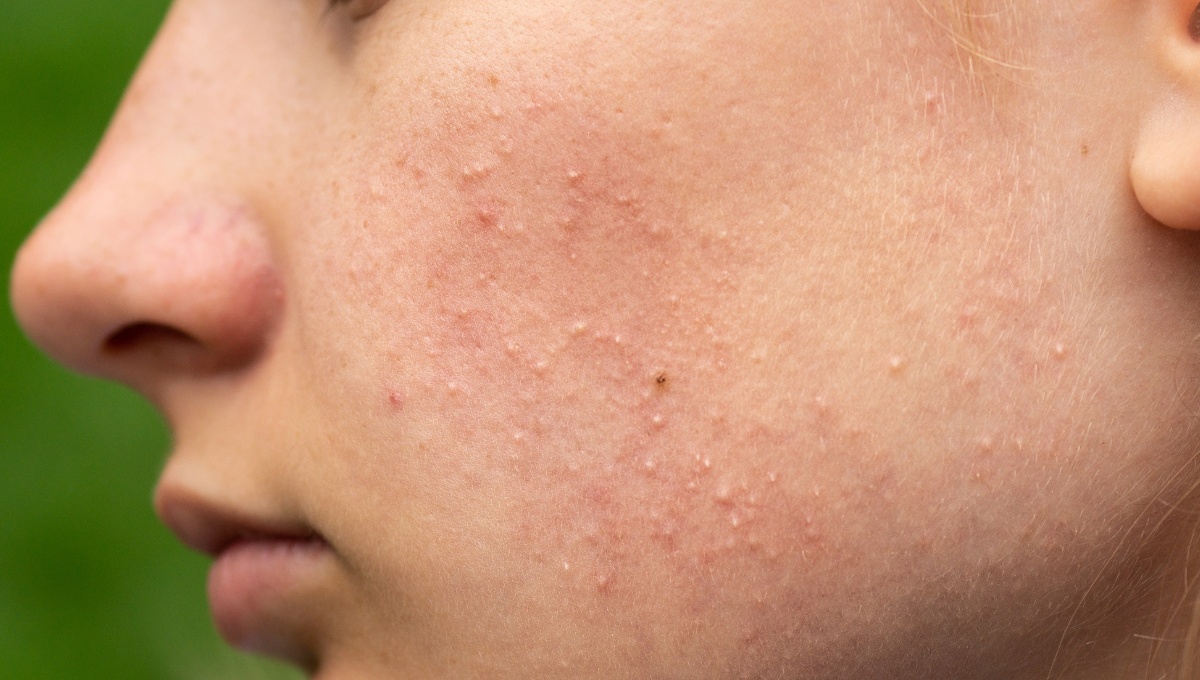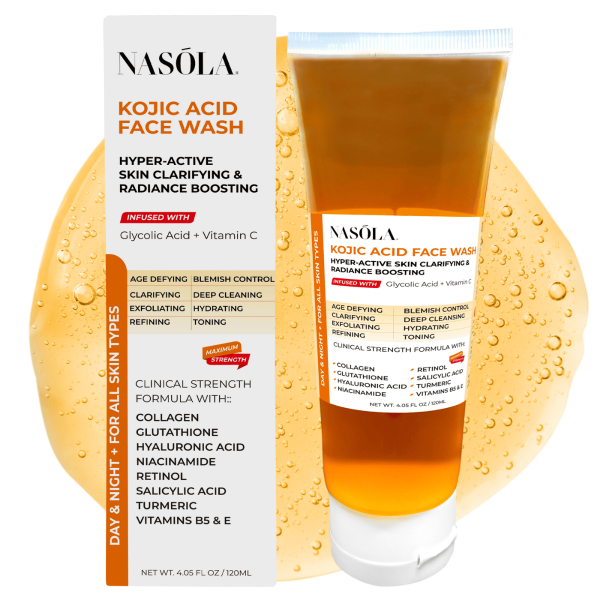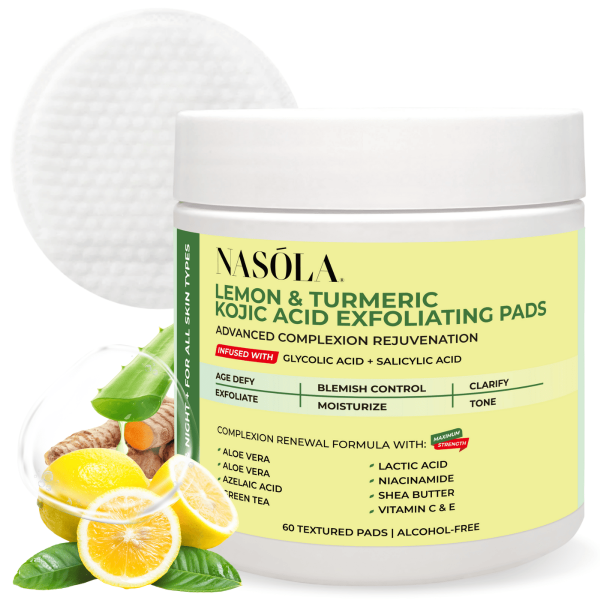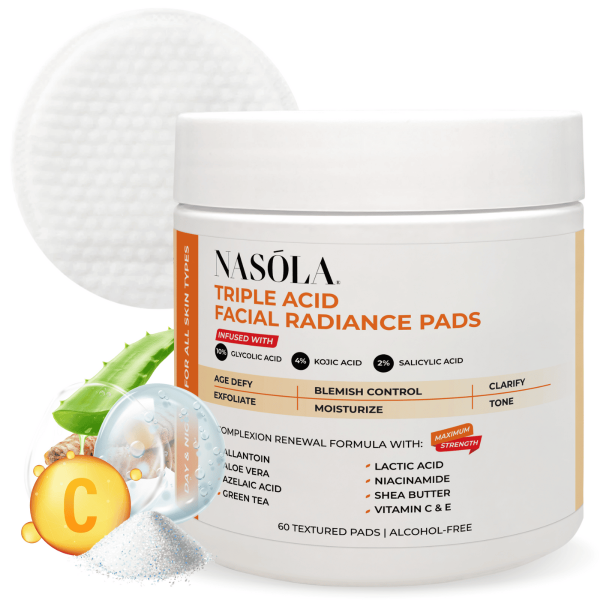If you’ve ever stared into the mirror, squinting at those lingering acne scars and thinking, “Why won’t you just go away already?” — you’re not alone.
And yes — I know that frustration all too well. So let’s talk about something that’s buzzing in the skincare world: Does salicylic acid help with acne scars?
It’s a question that floats through skincare forums, dominates Google searches, and lives rent-free in the minds of anyone who’s dealt with breakouts and their stubborn aftermath.
Salicylic acid has been a go-to ingredient for acne-prone skin for ages… but what about after the breakout clears and the scar stays?
In this post, we’re getting into the nitty-gritty of how salicylic acid works, what types of scars it targets, and why combining it with targeted products like the Nasola Kojic Acid Face Wash, Triple Acid Facial Radiance Pads, and Kojic Acid Facial Toner can transform your skincare game.
So, let’s get to the juicy stuff.
- Does Salicylic Acid Help with Acne Scars?
- Kojic Acid for Acne Scars
- Incorporating AHAs and BHAs for Smoother Skin
- Niacinamide’s Role in Acne Scar Treatment
- How to Build an Acne Scar-Fading Routine
- When Should You Expect Results from Salicylic Acid on Acne Scars?
- Common Mistakes When Using Salicylic Acid for Acne Scars
- The Myth vs. The Truth: Does Salicylic Acid Help with Acne Scars in All Skin Types?
- Conclusion
- Frequently Asked Questions
Does Salicylic Acid Help with Acne Scars?

When it comes to treating acne scars, salicylic acid often lands in top-recommended lists — and for good reason. Known for being a beta hydroxy acid (BHA), it’s oil-soluble and penetrates deep into your pores, sweeping away dead skin cells and excess sebum.
But wait — does salicylic acid help with acne scars or is it just another breakout buster?
Let’s unpack what it really does for post-acne marks.
What is Salicylic Acid?
Salicylic acid is the skincare quiet hero that dives deep into your pores like it knows exactly what it’s doing. It loosely binds the keratin in dead skin cells, breaking it apart to unclog and exfoliate from within.
What that means?
- Helps clear existing acne and prevent new ones.
- Gently resurfaces the top layers of skin.
- Reduces red and dark marks associated with acne.
- Promotes smoother, fresher-looking skin over time.
It’s not a harsh peel — instead, it’s like a slow burn (in the best way) that refreshes your skin layer by layer.
How It Works on Acne Scars
So… does it actually work on the scars?
Yes — especially the type known as post-inflammatory hyperpigmentation (PIH). The acid clears away the dull, scarred layer and promotes quicker cell turnover which fades dark spots naturally.
Now, if you’ve got deeper scars like ice-pick or boxcars, salicylic acid won’t fill them in. But it can reduce texture irregularity slightly and make your skin tone more even overall.
Enter the Nasola Triple Acid Facial Radiance Pads — a glow-giving powerhouse. These pads combine salicylic acid with glycolic and lactic acids for a trio of resurfacing benefits.
If your scars need a gentle but consistent push to fade — this is it. Simply swipe, wait, and glow.
Kojic Acid for Acne Scars
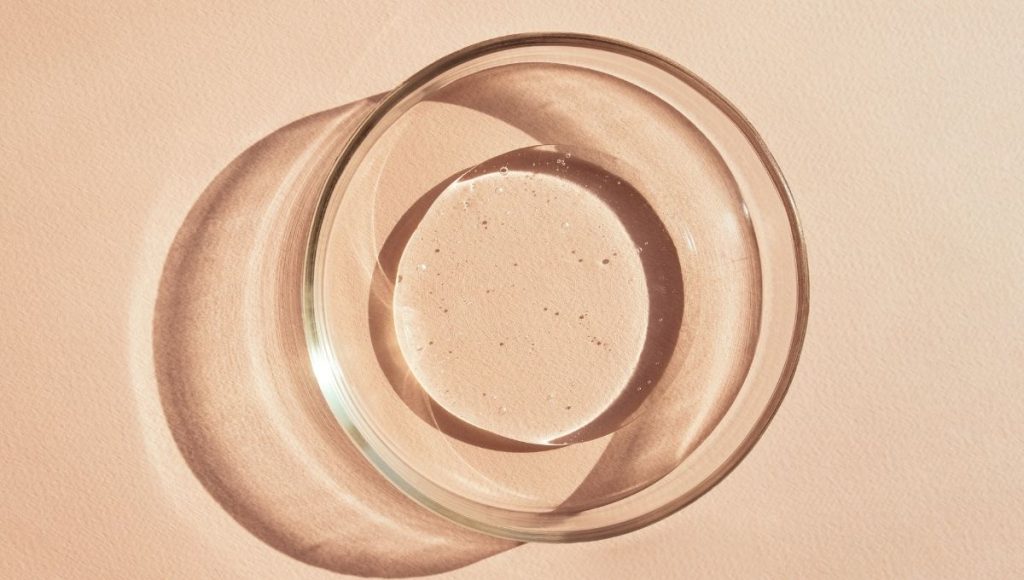
Now let’s spice things up with a natural skin-brightening MVP: kojic acid. If acne left behind more than just a bad memory — think patches, spots, or discoloration — kojic acid is a game-changer.
This ingredient, derived from fungi, works by inhibiting melanin production in the skin which makes it incredibly powerful against dark spots and hyperpigmentation.
What Is Kojic Acid and How It Helps
Kojic acid is like the friend who shows up to clean your house — efficiently and without drama. It lightens visible damage caused by acne, UV rays, and even aging.
- Reduces melanin production (bye dark spots!)
- Helps treat sun damage and hyperpigmentation
- Brightens skin without bleach or harshness
- Mild enough for consistent use
Pairing kojic acid with exfoliating ingredients results in faster, clearer skin.
Combating Hyperpigmentation
Got those dark little dots that just won’t leave? Kojic acid steps in to correct pigmentation without irritation.
The Nasola Kojic Acid Face Wash is a fantastic gateway into everyday brightening. It combines kojic acid with turmeric for anti-inflammatory benefits, making it a go-to for cleansing while also targeting acne scars. And YES — it’s gentle enough for daily use.
It’s your prep step before layering serums or pads. Think of it as setting the stage for the rest of your products to shine.
Incorporating AHAs and BHAs for Smoother Skin

We’ve praised salicylic and kojic acid individually… but when used together with other exfoliating heroes like glycolic and lactic acids? Magic.
These acids, known as AHAs (alpha hydroxy acids) and BHAs, complement each other — AHAs work on the skin’s surface while BHAs work deep within pores.
This powerful dynamic duo can gradually soften acne scars, brighten the complexion, and improve overall texture.
Role of Exfoliation in Scar Fading
Exfoliation is the silent miracle worker that most people overlook. It removes the skin’s topmost dead layer while signaling your body to make more new skin.
- Removes dead cells blocking newer skin
- Boosts collagen over time with regular use
- Prepares skin for better ingredient absorption
- Evens out pigment irregularities gradually
In scar-care, exfoliation needs to be consistent – not aggressive.
Pairing AHAs & BHAs for Enhanced Results
If you want something easy and quick to use after a busy day, give Nasola Lemon Turmeric Kojic Acid Exfoliating Pads a try.
These pads blend kojic acid, lemon extract, turmeric, and glycolic acid… Basically, it’s the multitasker of exfoliants.
We’ve recommended it to friends who needed brightening, smoothing, AND scar reduction—every single one came back grateful.
No mess. No fuss. One swipe across the face — and that’s it.
Niacinamide’s Role in Acne Scar Treatment
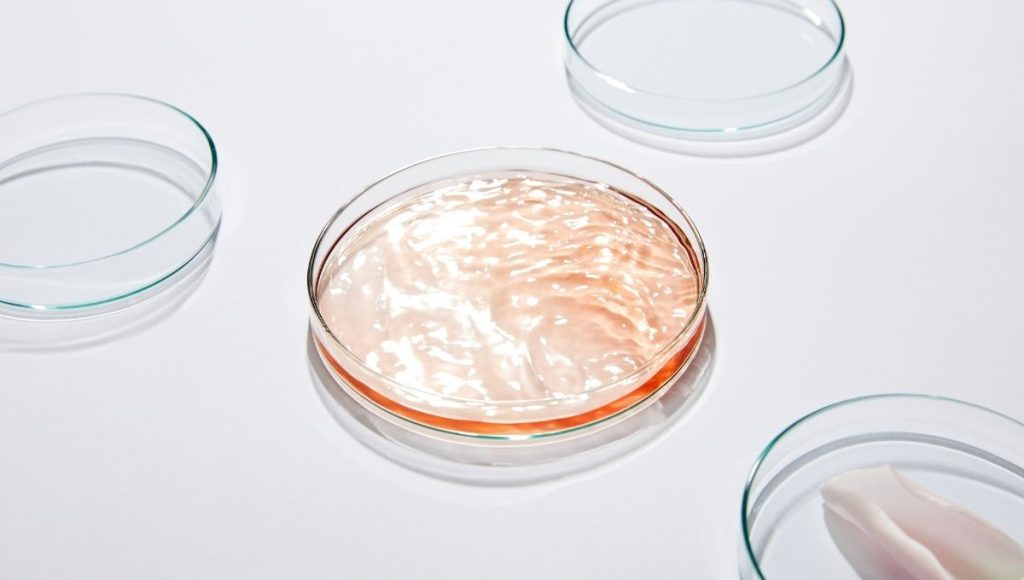
While acids remove, niacinamide restores. It calms, brightens, and helps the skin rebuild what has been worn down. Pairing it with salicylic acid often decreases irritation too, making it a prep-and-protect kind of player.
This skin-loving Vitamin B3 builds your skin’s resilience while brightening tone — both of which you need post-acne.
What is Niacinamide and How It Works
Niacinamide is that mild-mannered but smart ingredient that completely changes the game quietly in the background:
- Strengthens skin barrier after exfoliation
- Reduces redness and irritation
- Fades hyperpigmentation without harshness
- Improves hydration and elasticity
It acts like a shield and a repairman all in one.
Niacinamide and Salicylic Acid Synergy
Think of niacinamide as salicylic acid’s PR team. It soothes everything while backing up the brightening benefits.
A fantastic product to pair here is the Nasola Kojic Acid Facial Toner. It’s perfectly balanced and preps skin for niacinamide-infused serums, locking in benefits without triggering irritation.
How to Build an Acne Scar-Fading Routine

Consistency + the right order = results. It’s not about throwing every product on your skin at once — it’s knowing what goes where, and how often.
Whether you’re new or experienced, a good acne scar-fading routine should include:
Start Slow with Actives
Introduce one new product at a time and never overdo it. Your skin will thank you later.
- Patch test every active ingredient upfront
- Use exfoliants 2–3x/week to begin
- Hydrate and protect your barrier DAILY
- Wear SPF — like, religiously
Your skin is a living organ. Don’t drown it in too much actives at once.
Step-by-Step Skincare Routine
Here’s a solid sample regimen built with Nasola products you can trust:
- Cleanser: Kojic Acid Face Wash
- Toner: Kojic Acid Facial Toner
- Treatment/Exfoliant: Triple Acid Facial Radiance Pads or Lemon Turmeric Kojic Acid Pads
- Hydration: Your fav moisturizer
- Protection (Daytime): SPF 30 or higher
Keep it simple, stick to it… and your skin will show up for you.
When Should You Expect Results from Salicylic Acid on Acne Scars?

We want results, and we want them fast. But let’s set realistic expectations. With consistent use, products featuring salicylic acid can show visible scar-fading results in stages.
Initial Changes
First signs of improvement include smoother texture, reduced inflammation, and a glow that wasn’t there before.
This typically happens within 2–4 weeks depending on how your skin responds.
- Pore congestion reduces
- Acne frequency drops
- Skin feels smoother
- Redness begins to fade
Long-Term Fading
Patience matters. You’ll start seeing real pigmentation fading between 6–12 weeks with consistent use of salicylic acid.
Factors affecting this include:
- Skin type and tone
- Frequency of treatment
- Sun exposure habits
- Pairing with calming agents like niacinamide
Play the long game — your future self will thank you.
Common Mistakes When Using Salicylic Acid for Acne Scars

We’ve all jumped into a new product too fast and regretted it.
So… here’s where people go wrong.
Over-Exfoliation
Doing too much too soon will wreck your skin barrier — and possibly make scars worse.
- Don’t use multiple acids daily.
- Space exfoliants 2–3 days apart.
- Always moisturize after applying actives.
- Use barrier-repairing ingredients like niacinamide.
Product Layering Errors
Active overload is a real thing. Keep it simple and intentional.
- Layer thinnest to thickest
- Use acids at night due to photosensitivity
- Patch test new combos
- Give products 2–3 weeks to evaluate effect
Improvement takes time — not product overload.
The Myth vs. The Truth: Does Salicylic Acid Help with Acne Scars in All Skin Types?

One key question I get: “Can I use salicylic acid if I have sensitive skin or darker skin tones?”
Here’s what you should know.
Does Salicylic Acid Work on All Skin Tones?
Yes, but application strategy matters.
- Works well on oily and combination skin types
- Safe for deeper skin tones when not overused
- Always pair with sunscreen to prevent rebound pigmentation
- Use low concentrations initially (0.5–2%)
Make sure your other skincare products aren’t counteracting the salicylic acid’s calming properties.
Tips for Sensitive or Dry Skin Users
If you’re sensitive (hi, welcome—we exist!), avoid harsh cleansers and maintain hydration.
- Buffer salicylic acid between toner and moisturizer
- Apply on alternate days
- Avoid alcohol-based products
- Use ceramide-rich moisturizers
Start small. Build up over time. And always listen to your skin!
Conclusion
So, let’s bring it home: Does salicylic acid help with acne scars? Yes — especially when it comes to fading hyperpigmentation, smoothing mild texture issues, and preventing new breakouts.
It’s not a miracle overnight fix, but it’s definitely a powerful tool when used correctly and paired with the right teammates.
Want real progress? Focus on a balanced regimen featuring gentle AHAs, kojic acid for pigmentation, soothing niacinamide, and — of course — salicylic acid.
Products like Nasola Triple Acid Facial Radiance Pads and Kojic Acid Face Wash are excellent ways to layer in skin-changing magic.
Be consistent. Hydrate and protect your skin barrier like it’s your job. And trust that you’re doing enough.
You’ve got this.
Frequently Asked Questions
Salicylic acid helps fade pigmentation and mild surface scars but won’t remove deep scarring. For ice-pick or boxcar scars, treatments like microneedling may be better. However, salicylic acid can make your skin smoother, clearer, and more even over time — especially with consistent use.
Most people see subtle improvements within 4 weeks, but deeper fading takes 6-12 weeks. Consistency is key. Combine with other effective ingredients like kojic acid or niacinamide to boost the process. Product layering and SPF use will also affect speed of results.
Yes, kojic acid specializes in inhibiting melanin production, making it ideal for dark spot treatment. Salicylic acid helps resurface and manage breakouts. Using both together gives targeted brightening and exfoliation. Try the Nasola Kojic Acid Face Wash with Triple Acid Pads for full-spectrum care.
For best results, use products that blend salicylic, glycolic, lactic, and kojic acids. Try these:
– Nasola Triple Acid Facial Radiance Pads
– Nasola Lemon Turmeric Kojic Acid Pads
– Nasola Kojic Acid Face Wash
Absolutely! In fact, they complement each other. While salicylic acid exfoliates, niacinamide soothes and restores the skin barrier. Use salicylic acid first, then apply niacinamide serums. This combo helps balance the skin and reduce flare-ups!
If it’s in a lower concentration (<2%), yes — but listen to your skin. Start with 2–3 times weekly, then gradually increase. Overuse can lead to a compromised barrier. Alternate with hydrating products and always pair with a moisturizer.
Absolutely. Always follow up with a good moisturizer to rehydrate the skin and support healing post-exfoliation. Skip this? Expect dryness or peeling. Moisturizing is a vital step no matter your skin type.
Try this:
1. Clean with Nasola Kojic Acid Face Wash
2. Tone with Kojic Acid Facial Toner
3. Treat with Triple Acid Facial Radiance Pads
4. Moisturize
5. SPF daily (morning only)

